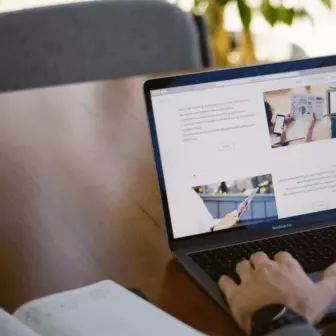All You Need To Know About The Web Development For Your EdTech Startup
EdTech startups are revolutionizing the future of education. Now is the best time to launch your idea on the market. Whether you want to compete directly with schools and colleges or collaborate with an educational institution to enhance the classroom experience, both these business models can become profitable. According to EdTechXGlobal, EdTech will turn into a $252 billion industry by 2020 thanks to a 17% annual growth.

However, keep in mind that you will also have many competitors. In addition to big names like Microsoft and Apple, which have joined in on the EdTech innovations, many other companies have created great EdTech products (Coursera, Big Think, and Khan Academy). To thrive on the market, you need to consolidate your business strategy, starting with web development. With that in mind, let’s take a closer look at several important factors associated with web development when it comes to launching, maintaining and growing your EdTech startup.
Identify the Needs of the Client and the User
Even if your platform will serve children, parents and teachers will be the ones to make a purchase. When establishing your features and user experience, you need to keep both these targets in mind. Market research can help you understand the “pain points” of your target audience and develop solutions that solve these problems.
Cynthia Brook, Head of Content Development at WoWGrade had this to say on the topic: “There is little point in developing a web-based platform without being familiar with what your target audience might expect in terms of content and UX. Make sure to research the market and build on what came before in order to come out on top in your respective industry.”
In this regard, it’s good practice to audit several EdTech platforms which correspond with your planned service portfolio such as Udemy or Lynda. These platforms can give you a good indication of what the market expectations are and how you can match those standards in your own website.
Put your Ideas on Paper
Your thoughts have yet to be tested for viability. However, it’s entirely possible to develop intriguing and creative EdTech startup platforms based on initial brainstorming ideas. Grab a piece of paper and create a mind map of your web development ideas, possible features, long-term goals and other elements vital to your startup’s growth.
This approach to web development can also be used for technical aspects of your website’s branding – to make logo or visual identity which will help your site stand out even more. Create a mockup of your intended product or even design a crude landing page. This will help you to have a better understanding of possible weak spots. Thus you can determine your audience more precisely and estimate how much time and money you’ll need to spend on the project.
Outsourcing Web Development
EdTech services are complex and time-consuming to develop. Dealing with development in-houses isn’t always the right course of action financially speaking. This is especially true of your EdTech services won’t revolve around programming, design or other industries related to web development. Make sure to choose your web developers carefully and inquire about long-term contracts during your initial negotiation.
Chances are that you will want to expand your service portfolio or conduct scheduled maintenance, making a reliable web developer a worthy investment on its own. Outsourcing web development helps you save money and your team can focus more on coming up with innovative solutions and marketing the product. Most importantly, it can help shift your resources into content creation and brand placement which are essential elements of attracting the first batch of your leads once you go live.
Come up with a Prototype
Start from the general framework of your website and make your way down to minute details. At first, aim to create a rough prototype that will perfectly depict the idea of the product and ways how potential clients will interact with it. It’s good practice to allow several members of your team to provide feedback on how the project is moving along before visual and contextual elements fall into place.
That being said, it’s important to test different models and structures. Dive into the careful design to make the thing look appealing to both casual learners and professional life-long-learning fans. Visual presentation of your EdTech startup’s website is just as important as its functionality. If you don’t have a visual artist or a graphic designer in-house, you can outsource this segment of your web development via platforms such as 99 Designs and look for an adequate professional there.
Simplicity and Engagement
The very aim of EdTech is to simplify the learning experience and make it more engaging by using technology. Therefore, your platform must be intuitive, simple, user-friendly, and have a fast loading time. This will not only affect the end-users’ retention but also your website’s overall SEO ranking on search engines such as Google and Bing. In order to ensure that both of these factors are facilitated and present on your site, you should optimize your back-end code, rely on keyword-friendly content and conduct frequent multimedia content optimization.
Keep in mind that the teachers who buy your product might not be tech-experts or pay for someone to invest in training, so using your platform should have a short learning curve. You can go a step further and create an FAQ page with the option to contact one of your representatives via a chatbot or live conversation. Provide your tutors and learners with the means to learn how to use your EdTech website efficiently and they will return the favor in spades.
Usability Testing
When your platform is ready to accept its first paying end-users, it should be functional and bug-free. Usability testing is very important if you want to make sure every feature works as intended. You can go about usability testing in a number of ways, including in-house quality assurance (QA) runs, AI-powered testing or controlled user group tests. You can choose one or several usability testing methods based on your platform’s scale, complexity and the resources available to you.
User groups (with NDAs) are a great way to find out which services and UX functionality the users will use the most and in which order. On the other hand, automated AI testing can help you find technical bugs, loading bottlenecks and other errors associated with repeated use of your website. Make sure you conduct careful testing and bug-fixing before your platform goes live on a global level to ensure positive reception from day one.
In Summary
As with any web-based startup project, EdTech will require certain time and resources on your part due to its complex development process. However, once your platform is live and your return on investment (ROI) starts coming in, you will quickly discover that people are more than happy to use online learning platforms as a means to develop their skillsets.
Find a happy medium between original learning content, pro-active tutors and web development standards which suit your brand’s image and visuals. In time, the right audience will flock around your platform and spread positive word of mouth to their social circles, ensuring your website’s longevity and organic growth as a result.
Subscribe
Related Blogs
Why should you prioritize lean digital in your company?

We are living in an era where the change and innovation rate is just so high. If you want your organization to reach new…
How to measure your open source program’s success?

Along with active participation, it is very important to look after the ROI of open-source projects, programs, and…
Understanding the significance of participating in open-source communities

Do you think contributing to the open source community can be difficult? I don’t think so. Do you have to be employed by a…



